Life Energy Beliefs
L
Life Force Ideas Around the World
Here are the L entries of life energy beliefs around the world and from antiquity to the present. An edited and expanded version of this Life Energy A to Z is published in my book
Life Energy Encyclopedia.
L
L-field see life field.
Labuni is a word for the life force used by the tribe Gelaria in New
Guinea, according to C. G. Jung in his book On the nature of the Psyche.
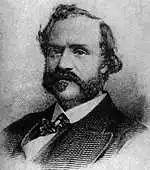
Latent neutral is an expression introduced by the American John Worrell
Keely (1827-1898) for a receiving spirit in all matter, which he called the
soul of matter. It is an element that defies any definition. What it receives
is celestial radiation, the force in space that creates movement and life, and
was released at the birth of the universe. Keely called his theory
sympathetic vibrational psysics.
Lebenskraft see dynamis.
Leza see mulungu.
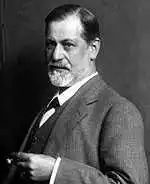
Libido (Latin for desire and lust) is a term for all kinds of psychic energy,
introduced by the Austrian Psychoanalyst Sigmund Freud (1856-1939).
The term has gotten a sexual connotation, but Freud used it for every form
of psychic energy, expressed in thought, perception, fantasy, memory,
desire, and so on. He claimed that this energy exists in a fixed quantity in
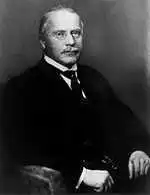 each human, but moves between different expressions. The consequence is
that focus on one expression makes the others weaken, sometimes to the
extent that it leads to neurosis. The German Psychoanalyst C. G. Jung
(1875-1961) had a partially altered and widened view on libido as a strife
for balance. The similarity to life energy such as qi is limited. Libido is more about purely
mental states.
each human, but moves between different expressions. The consequence is
that focus on one expression makes the others weaken, sometimes to the
extent that it leads to neurosis. The German Psychoanalyst C. G. Jung
(1875-1961) had a partially altered and widened view on libido as a strife
for balance. The similarity to life energy such as qi is limited. Libido is more about purely
mental states.
Life (Latin vita, Greek bios) is not easy to define. In past times it has been
regarded as either filling all of cosmos, or just present in humans, animals,
and to a lesser degree in plants. In the animal kingdom, the difference
between life and death is evident, so in practice the definition has really
been that those who are not dead must be alive. Modern medicine,
though, has the ability to make this border blurred. Humans have always
wondered about exactly what it is that ceases when life shifts to death. Out
of these speculations, ideas about a life force and the like have been born.
The belief in a life spirit probably stems from the fact that breathing stops
at death. The exhalation of the last breath has surely stimulated the belief
in an escaping spirit. We are born with an inhalation, like when the
Biblical God blew life into Adam, and we die with an exhalation (see also
breath). Also the rich symbolic meaning of the heart in traditional thought
can be linked to the fact that it stops beating at the moment of death.
Modern natural science has no single definition of life, apart from the
thesis that it consists of nothing but known biochemical processes. Life
contains the demand for some kind of movement and change, also growth
– all the way from the nourishment intake and multiplying by division of
unicellular creatures, to the birth, growth, and multiplying of mammals. It
is more questionable if life as such depends on death, the inevitable
demise of any individual life form. Although none have been found,
creatures with eternal life must also be regarded as alive if they move and
act and change somehow. Many but far from all deities in myths around
the world have eternal life as their major trait. Most deities seem unable to
die by old age, or to age at all, but can still be killed – mostly only by other
deities (see also gods). Where a driving force of life is pointed out by
natural science, it is the gene, which is in modern biology described as sort
of a motor and meaning to procreation. Historically, the driving force has
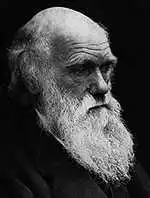 been searched in the whole of the animal, or the whole species. Charles
Darwin (1809-82) spoke about the fight for survival of the species. Most
theories before his focused on the individual creature's strife for eternal
life through its offspring. Both these theories are easily combined in
pointing out the will of the individual, as opposed to the impersonal drive
of genetics. Among humans, life has traditionally been regarded as
awareness of it – knowing to be alive, and thus to have an I. Since life, in
that case, is connected to the individual experience, 'I live,' it would be
impossible to reach the same certainty about the state of death, because it
would demand the experience 'I am dead' – but that would be just another
way of being alive. It would confirm the necessity for life after death,
which in turn would deny the existence of death altogether.
been searched in the whole of the animal, or the whole species. Charles
Darwin (1809-82) spoke about the fight for survival of the species. Most
theories before his focused on the individual creature's strife for eternal
life through its offspring. Both these theories are easily combined in
pointing out the will of the individual, as opposed to the impersonal drive
of genetics. Among humans, life has traditionally been regarded as
awareness of it – knowing to be alive, and thus to have an I. Since life, in
that case, is connected to the individual experience, 'I live,' it would be
impossible to reach the same certainty about the state of death, because it
would demand the experience 'I am dead' – but that would be just another
way of being alive. It would confirm the necessity for life after death,
which in turn would deny the existence of death altogether.
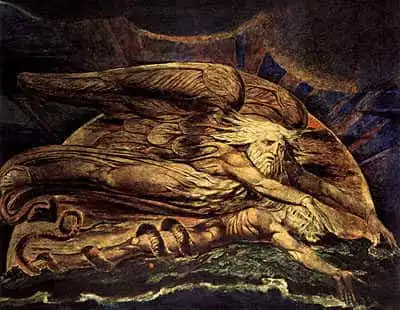
God creating Adam, by William Blake 1795.
Life body see life ether.
Life elixir see longevity.
Life energy is an expression commonly used today for ideas about a kind
of energy that might be the source for life in animals and plants, in
addition to the biological processes at work. The expression implies that
this life source is a type of energy, comparable to radiation, electricity, and
so on. This view is contemporary, being inspired by the scientific
explorations of electricity and radiation in the 19th and 20th centuries, also
Einstein's thesis about the relation between matter and energy – basically
that they are in essence the same. Compare life force and life spirit.
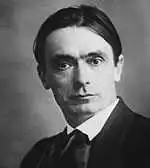
Life ether is an expression used in anthroposophy, founded by Rudolf
Steiner (1861-1925). He regarded humans as consisting of four parts:
physical body, ether body, astral body, and ego, where the two latter are able to
leave the body, for example in sleep and by incarnation. The ether body,
also called the life body, is a transparent cover around the physical body, a
receiver of impulses from the four ethers heat, light, sound, and life, which
are heavenly counterparts to the Greek elements fire, air, water, and earth.
So, the life ether is linked to earth, the last step in the creation of the world
through the previous ethers and elements. The idea of the life ether might
be the nearest to the life energy concept, but to some extent all the ethers are
connected and cooperate.
Life field is an expression for the body's energy field, introduced in 1972
by the American Professor of Medicine Harold Saxon Burr (1889-1973),
who researched this in 1932-1956. He claimed that diseases could be traced
to this field, and be prevented or cured by changes in people's life fields.
These fields are electric and magnetic, and disappear when people die.
The English author Edward Wriothesley Russell called them L-fields in
books from the 1970s. See also T-field.
Life force is a traditional expression for a driving force of life, of an
incorporeal kind, although at work in the body. The expression implies a
will-power with its own purpose, which is also how it was often perceived
in past times. In this perspective the life force was a primordial or divine
power, setting the living beings of the world in motion. Modern concepts
of a life source tend instead to compare it to energy, not necessarily
originating in some kind of will, or aiming toward some kind of goal.
Compare life energy and life spirit. See also dynamis.
Life spirit is an expression for ideas about some kind of essence in living
beings, bringing them to life and keeping them alive. The expression
implies that this essence is a kind of ether, incorporeal although at work in
bodies, maybe also immaterial. It is almost a tautology, since the word
spirit implies just about the same. Within New Age and occult traditions,
the expression is probably used to distinguish it from ideas of a life source
that are material and mechanical in nature. See also spirit and élan vital.
Light has always been regarded as connected to divine powers, which is
easily explained by its major source, the sun, being a heavenly body as
distant as it was bewildering to ancient humans. Many mythologies
contain stories of how fire (see this word) was stolen or given from
heavenly powers, as if snatched from the very sun. The sun (see this word)
is a high deity in many cultures, often regarded as essential already in
creation, bringing light and warmth. Light is the first creative act of the
Biblical god in Genesis: “Let there be light!” Thereby darkness was
conquered, and the rest of creation became possible. The traditional link
between light and heat (see this word) is such that light is connected to
heat and life, whereas darkness is connected to cold and death. This basic
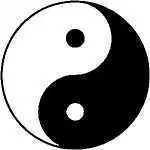 polarity is found in many traditions, such as the Chinese yin and yang,
originally referring to the shady and sunny side (for example of a tree).
Yin is regarded as earthly and yang heavenly. The fact that light is
possible to block, creating shade, must have fascinated the minds of
ancient humans. From this observation, and that of the change between
night and day, they imagined a constant battle between light and dark,
where the former had so much more to offer mankind, and therefore
gained their sympathy. The differences between light and heat may have
influenced people to form ideas of spirit and soul, the one more elevated
and abstract than the other. To ancient man, light was less tangible than
heat, and more difficult to induce. Therefore it is plausible that while heat
can have stimulated ideas about a flowing life force partially controllable
by the will, light gave ideas about a heavenly energy, given from above,
outside of human control. The significance of light in the human mind is
difficult to exaggerate. In modern society, we have it at the reach of a
switch, but primitive man was completely at the mercy of the heavenly
lights, before he learned to make fire (see this word). Darkness was a state
of dire and dangerous helplessness, from which each dawn brought
liberation. The concern since the dawn of civilization for celestial matters,
is probably because of heaven's ancient monopoly on light. Ideas of an
inner light are not likely to have appeared before humans learned to make
fire, which is to bring out the light and heat from inside objects that
beforehand are cold, with dark interiors. By fire, light could be made to
emerge from earthly objects. Human use of fire was probably originally
for the light of it, more than the heat. See also aura.
polarity is found in many traditions, such as the Chinese yin and yang,
originally referring to the shady and sunny side (for example of a tree).
Yin is regarded as earthly and yang heavenly. The fact that light is
possible to block, creating shade, must have fascinated the minds of
ancient humans. From this observation, and that of the change between
night and day, they imagined a constant battle between light and dark,
where the former had so much more to offer mankind, and therefore
gained their sympathy. The differences between light and heat may have
influenced people to form ideas of spirit and soul, the one more elevated
and abstract than the other. To ancient man, light was less tangible than
heat, and more difficult to induce. Therefore it is plausible that while heat
can have stimulated ideas about a flowing life force partially controllable
by the will, light gave ideas about a heavenly energy, given from above,
outside of human control. The significance of light in the human mind is
difficult to exaggerate. In modern society, we have it at the reach of a
switch, but primitive man was completely at the mercy of the heavenly
lights, before he learned to make fire (see this word). Darkness was a state
of dire and dangerous helplessness, from which each dawn brought
liberation. The concern since the dawn of civilization for celestial matters,
is probably because of heaven's ancient monopoly on light. Ideas of an
inner light are not likely to have appeared before humans learned to make
fire, which is to bring out the light and heat from inside objects that
beforehand are cold, with dark interiors. By fire, light could be made to
emerge from earthly objects. Human use of fire was probably originally
for the light of it, more than the heat. See also aura.
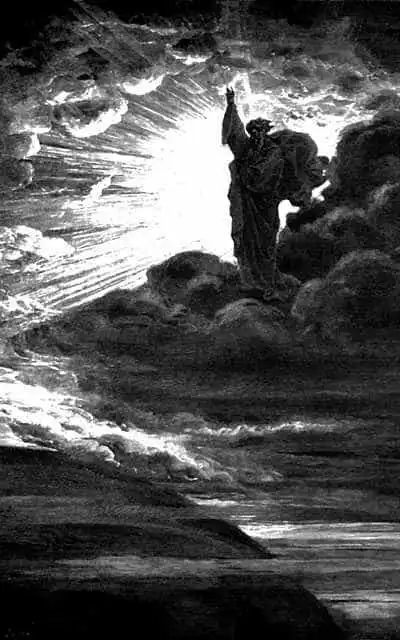
God creates light. Bible illustration by Gustave Doré, 1866.
Logoital plasma see eloptic energy.
Longevity is having a long life, something intensely strived for through
many different means in many cultures. This is certainly still the case in
our modern society. Where we have medicines and nutritional additives,
there were numerous experiments in the past to come up with a life elixir
(see this word), some kind of potion that stopped ageing completely. The
religious Taoists of old made one containing heavy metals, making it quite
poisonous. The alchemists of Medieval and Renaissance Europe were
focused on making gold, but nourished the idea that humans could
transform to a “golden” level of refinement and awareness, also bringing
longevity. Longevity has in many traditions been closely linked to what is
presently called life quality, a life that is not just long but has other
qualities as well. It has often been assumed that such qualities promote
longevity, whereas the opposite is not necessarily the case.
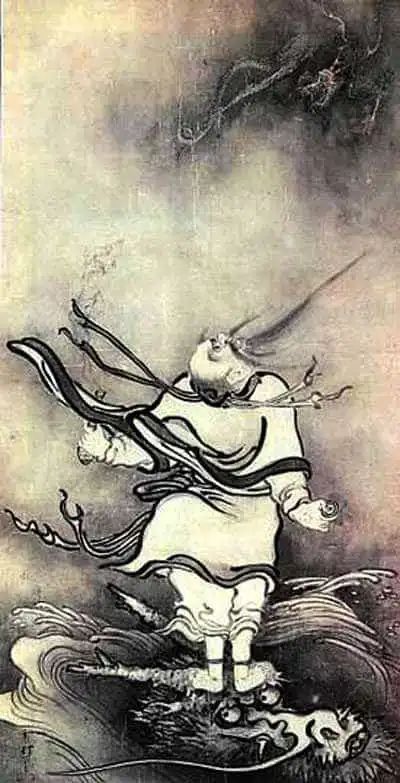
The Taoist immortal Lu Tung-Pin.
Luster can be used symbolically about people, referring to what can also
be described as charisma (see this word), the impression a person makes on
others. Luster is often mentioned as a quality of persons who have reached
a high level of spiritual clarity or religious piety, but can also describe a
specific human characteristic of a more profane nature. In alchemy, a far
developed personality was believed to express itself with a visible luster.
There are also many ideas about an inner light in exemplary humans. See
also light, nimbus, aura, and halo.
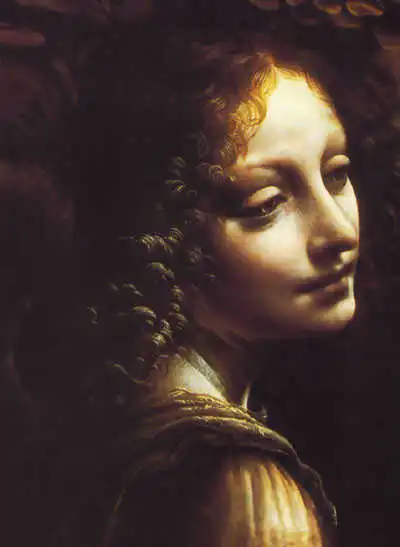
An angel's face with evident luster. Detail from Virgin of the Rocks, painted by Leonardo da Vinci in the 1480s.
Life Energy Beliefs from A to Z
|
My Life Energy Books
Qi, prana, spirit, ruach, pneuma, and many other life forces around the world explained and compared. Click the image to see the book at Amazon (paid link).
The life energy qi (also chi or ki) explained, with several very easy exercises to awaken, increase, and use it. Click the image to see the book at Amazon (paid link).
|
My Other Websites
The ancient Chinese life energy
qi (
chi) explained and how to exercise it.
Creation stories from around the world, and the ancient cosmology they reveal.
What the Greek philosophers believed about the cosmos, their religion and their gods.
Taoism, the ancient Chinese philosophy of life explained. Also, the complete Tao Te Ching online.
Other Books of Mine
The Greek philosophers and what they thought about cosmology, myth, and the gods.
Click the image to see the book at Amazon (paid link).
This book examines Jungian theories on myth and religion, from Carl G. Jung to Jordan B. Peterson.
Click the image to see the book at Amazon (paid link).
The Taoism of Lao Tzu Explained. The great Taoist classic, translated and extensively commented chapter by chapter.
Click the image to see the book at Amazon (paid link).
Erroneous Tao Te Ching Citations Examined. 90 of the most spread false Lao Tzu quotes, why they are false and where they are really from.
Click the image to see the book at Amazon (paid link).
About me
I'm a Swedish author and historian of ideas, researching the thought patterns in creation myths. I've also written books about Taoism, the Tarot, and life force concepts around the world.
Click the image to get to my personal website.
 Cosmos of the Ancients
Cosmos of the Ancients Archetypes of Mythology
Archetypes of Mythology Tao Te Ching
Tao Te Ching Fake Lao Tzu Quotes
Fake Lao Tzu Quotes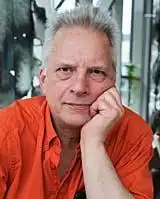 Stefan Stenudd
Stefan Stenudd

 each human, but moves between different expressions. The consequence is
that focus on one expression makes the others weaken, sometimes to the
extent that it leads to neurosis. The German Psychoanalyst C. G. Jung
(1875-1961) had a partially altered and widened view on libido as a strife
for balance. The similarity to life energy such as qi is limited. Libido is more about purely
mental states.
each human, but moves between different expressions. The consequence is
that focus on one expression makes the others weaken, sometimes to the
extent that it leads to neurosis. The German Psychoanalyst C. G. Jung
(1875-1961) had a partially altered and widened view on libido as a strife
for balance. The similarity to life energy such as qi is limited. Libido is more about purely
mental states. been searched in the whole of the animal, or the whole species. Charles
Darwin (1809-82) spoke about the fight for survival of the species. Most
theories before his focused on the individual creature's strife for eternal
life through its offspring. Both these theories are easily combined in
pointing out the will of the individual, as opposed to the impersonal drive
of genetics. Among humans, life has traditionally been regarded as
awareness of it – knowing to be alive, and thus to have an I. Since life, in
that case, is connected to the individual experience, 'I live,' it would be
impossible to reach the same certainty about the state of death, because it
would demand the experience 'I am dead' – but that would be just another
way of being alive. It would confirm the necessity for life after death,
which in turn would deny the existence of death altogether.
been searched in the whole of the animal, or the whole species. Charles
Darwin (1809-82) spoke about the fight for survival of the species. Most
theories before his focused on the individual creature's strife for eternal
life through its offspring. Both these theories are easily combined in
pointing out the will of the individual, as opposed to the impersonal drive
of genetics. Among humans, life has traditionally been regarded as
awareness of it – knowing to be alive, and thus to have an I. Since life, in
that case, is connected to the individual experience, 'I live,' it would be
impossible to reach the same certainty about the state of death, because it
would demand the experience 'I am dead' – but that would be just another
way of being alive. It would confirm the necessity for life after death,
which in turn would deny the existence of death altogether.

 polarity is found in many traditions, such as the Chinese yin and yang,
originally referring to the shady and sunny side (for example of a tree).
Yin is regarded as earthly and yang heavenly. The fact that light is
possible to block, creating shade, must have fascinated the minds of
ancient humans. From this observation, and that of the change between
night and day, they imagined a constant battle between light and dark,
where the former had so much more to offer mankind, and therefore
gained their sympathy. The differences between light and heat may have
influenced people to form ideas of spirit and soul, the one more elevated
and abstract than the other. To ancient man, light was less tangible than
heat, and more difficult to induce. Therefore it is plausible that while heat
can have stimulated ideas about a flowing life force partially controllable
by the will, light gave ideas about a heavenly energy, given from above,
outside of human control. The significance of light in the human mind is
difficult to exaggerate. In modern society, we have it at the reach of a
switch, but primitive man was completely at the mercy of the heavenly
lights, before he learned to make fire (see this word). Darkness was a state
of dire and dangerous helplessness, from which each dawn brought
liberation. The concern since the dawn of civilization for celestial matters,
is probably because of heaven's ancient monopoly on light. Ideas of an
inner light are not likely to have appeared before humans learned to make
fire, which is to bring out the light and heat from inside objects that
beforehand are cold, with dark interiors. By fire, light could be made to
emerge from earthly objects. Human use of fire was probably originally
for the light of it, more than the heat. See also aura.
polarity is found in many traditions, such as the Chinese yin and yang,
originally referring to the shady and sunny side (for example of a tree).
Yin is regarded as earthly and yang heavenly. The fact that light is
possible to block, creating shade, must have fascinated the minds of
ancient humans. From this observation, and that of the change between
night and day, they imagined a constant battle between light and dark,
where the former had so much more to offer mankind, and therefore
gained their sympathy. The differences between light and heat may have
influenced people to form ideas of spirit and soul, the one more elevated
and abstract than the other. To ancient man, light was less tangible than
heat, and more difficult to induce. Therefore it is plausible that while heat
can have stimulated ideas about a flowing life force partially controllable
by the will, light gave ideas about a heavenly energy, given from above,
outside of human control. The significance of light in the human mind is
difficult to exaggerate. In modern society, we have it at the reach of a
switch, but primitive man was completely at the mercy of the heavenly
lights, before he learned to make fire (see this word). Darkness was a state
of dire and dangerous helplessness, from which each dawn brought
liberation. The concern since the dawn of civilization for celestial matters,
is probably because of heaven's ancient monopoly on light. Ideas of an
inner light are not likely to have appeared before humans learned to make
fire, which is to bring out the light and heat from inside objects that
beforehand are cold, with dark interiors. By fire, light could be made to
emerge from earthly objects. Human use of fire was probably originally
for the light of it, more than the heat. See also aura.


 Life Energy Encyclopedia
Life Energy Encyclopedia Qi — Increase your life energy
Qi — Increase your life energy